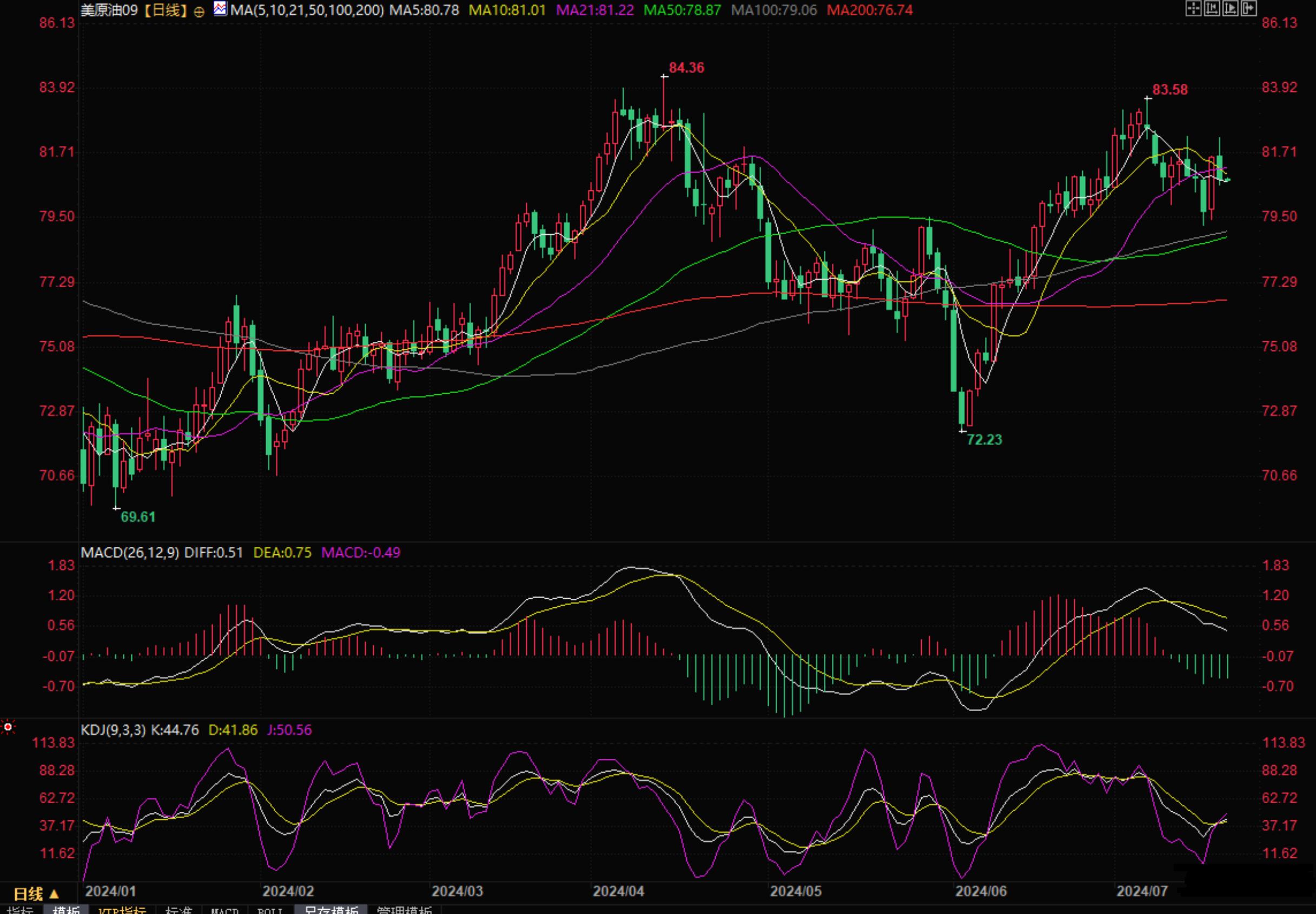Crude oil trading reminder: signals of economic slowdown once again suppress demand expectations, with oil prices falling nearly 1%
On Friday morning (July 19th) in the Asian market, international oil prices fluctuated narrowly, with September US crude oil futures currently trading around $80.79 per barrel. After being blocked from rising on Thursday, oil prices fell nearly 1%. Despite expectations of a Federal Reserve interest rate cut and a significant reduction in EIA crude oil inventories providing support for oil prices, concerns about a slowdown in the US economy have intensified, putting pressure on oil prices.
Brent crude oil futures fell 0.26% in September, closing at $85.11 per barrel. US crude oil futures fell 0.98% in September, closing at $80.83 per barrel. These two major indicators of crude oil have risen on the previous trading day.
As of the week ending July 1st, the increase in initial jobless claims in the United States exceeded expectations, with an increase of 20000 people applying for state unemployment benefits for the first time, bringing the seasonally adjusted number to 243000.
These data strengthen the reasons for the Federal Reserve to accelerate its interest rate cut plan, which may stimulate more oil spending.
Tamas Varga of oil broker PVM said, 'I believe that the healthy expectation of the Federal Reserve cutting interest rates in the near future will limit the downside space of the oil market.'.
Federal Reserve officials stated on Wednesday that, given the improved inflation trajectory and a more balanced labor market, the Fed is closer to cutting interest rates, which could pave the way for reducing borrowing costs in September.
The Beige Book released by the Federal Reserve on Wednesday showed that US economic activity expanded at a mild to moderate pace from late May to early July, and businesses expect future growth to slow down.
However, John Kilduff, a partner at Again Capital in New York, pointed out that the increase in the number of people claiming unemployment benefits also indicates an economic slowdown, which may reduce oil demand and prevent oil prices from rising.
Kilduff said that although government data released on Wednesday showed a decrease of 4.9 million barrels in US crude oil inventories last week, a decline greater than analysts' predictions, weak US gasoline demand prevented oil prices from rising.
San Francisco Fed President Mary Daly said on Thursday that before calling for a rate cut, she hopes to be more confident that inflation is returning to the Fed's 2% target.
The economic growth of Asia's largest crude oil importing country has also dragged down oil prices.
As expected, the ECB has kept interest rates unchanged without giving any indication of the next steps, believing that price pressures in the eurozone remain high and inflation rates will be higher than the target for a considerable period of time next year.
At the same time, three sources revealed that the small ministerial meeting of OPEC+held in August is unlikely to recommend changes to the organization's production policy, including lifting some oil production cuts from October onwards.
In terms of the US presidential election, a source said that US President Biden is seriously considering giving up running for re-election on behalf of the Democratic Party, while Trump is preparing to accept the Republican presidential nomination. His aides said he will give an unusual reflective speech.
The US dollar index rose 0.44% on Thursday, recovering most of Wednesday's losses and closing at 104.19, which also exerted some pressure on oil prices.
In terms of geopolitical situation, market expectations for a ceasefire agreement in the Middle East have increased, slightly dragging down oil prices.
On July 18th local time, Israeli sources reported that after Israeli Prime Minister Netanyahu proposed a new Gaza ceasefire and personnel exchange agreement negotiation "red line", the Israeli team responsible for indirect negotiations with the Palestinian Islamic Resistance Movement (Hamas) has been drafting a new draft agreement text to meet Netanyahu's demands, namely, to maintain Israel's control over the "Philadelphia Corridor" and the Gaza side of the Gaza Strip's border with Egypt in the first phase of the comprehensive ceasefire agreement, and to prevent Gaza militants from returning to northern Gaza.
It is reported that the negotiation team led by David Barnier, the head of Israel's intelligence and intelligence agency (Mossad), will not resume the relevant negotiation process in Qatar until the new draft text is approved by Netanyahu and the Israeli Council of Ministers. The new terms will only be handed over to mediators such as the United States, Qatar, and Egypt after being approved by Israel, and then to Hamas.
However, Israeli sources have stated that some of the new terms are not within the scope of the agreement draft previously proposed by Israel. The negotiating team believes that the new text "will break the negotiation deadlock," but negotiations with Hamas to finalize the details of the agreement will still take several weeks.
There was less economic data this trading day, so we should pay attention to the changes in the US crude oil drilling data and the speeches made by the officials of the Federal Reserve, and pay attention to the geopolitical situation and the news related to the US election.
From a technical perspective, the September US crude oil futures are at the daily level, with interwoven moving averages, MACD dead cross, KDJ golden cross, and a high possibility of short-term oil price fluctuations. It is recommended to pay attention to the breakthrough situation in the 79.06-82.27 region, where the former is supported by the 100 day moving average and the latter is the resistance of the high point in the past two weeks.

Daily chart of September US crude oil futures
Tips:This page came from Internet, which is not standing for FXCUE opinions of this website.
Statement:Contact us if the content violates the law or your rights
